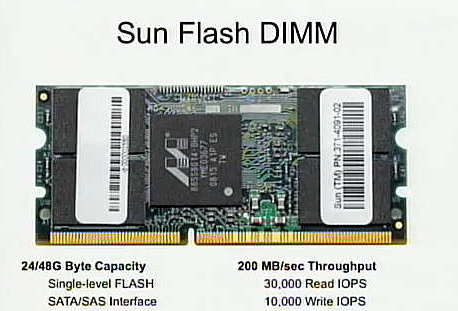Will flash DIMMs replace disks or DRAM?

Flash memory is opening a second front in its war on entrenched storage technologies. An unannounced Sun product is going to use 80 48 GB flash SO-DIMMs to create a 4 TB cache appliance.
Isn't "enhance" a nicer word than "replace?" Others are already looking at taking these large flash is SO-DIMMs and adding them to notebook computers. The flash DIMMs are accessed as disk drives through a thin driver, which makes them fast. As a disk look-alike they aren't a direct replacement for random access memory.The other big difference is capacity. 4 GB notebook SO-DIMMs have just come to market priced at over $100 per gigabyte. How the flash SO-DIMMs will be priced is still a mystery, but since the memory chips typically are over 90% of the cost of a DIMM, a 48 GB SO-DIMM should be less than $200.
Expensive compared to a disk drive, cheap compared to DRAM.
Peaceful coexistence? Many notebooks offer 2 SO-DIMM slots. Most casual notebook users -- reading e-mail and surfing the web -- are fine with 2 GB of RAM, leaving the second slot open for a 48 GB flash DIMM.
If the flash DIMM is configured as the boot device users will get most of the advantages of a more expensive SSD in a smaller and cheaper package. For many users 48 GB is all the capacity they need, making a disk optional.
The Storage Bits take None of the players are standing still. In 12 to 18 months that 48 GB flash DIMM will be 96 GB or more. The current high price for the 4 GB SO-DIMM will drop to reasonable levels. And drive vendors will be offering 1.5 TB 2.5 inch drives.
In 2 years notebook vendors could be offering a scaled-down version of the traditional enterprise tiered storage architecture: high-speed DRAM; fast SO-DIMM for booting, application and scratch storage; and a large capacity hard drive for bulk storage. Faster performance, more capacity, lower power consumption and cooler notebooks. It could be good.
However, as the bootable SD card slot in the new MacBooks shows, there is more than one way to get flash into a system. Some of us would like to be able to easily swap out boot drives on as the cards, but most of us will prefer to have our boot drive inside the notebook where it won't can't get lost. SB cards will also continue to have a significant cost advantage over flash SO-DIMMs due to high volume.
Of course, we don't know how well the new flash DIMMs will perform. Much depends on the quality of their embedded flash controllers, which often isn't too good in first-generation designs.
Flash DIMMs will take a piece out of both the DRAM and disk markets, but how much of each remains to be seen. What is clear is that we the consumers all benefit by more competition for our storage dollars. And designers have a better set of options for future system designs.
Comments welcome, of course. I worked in Sun's storage group for 3 years in the mid-90s.
